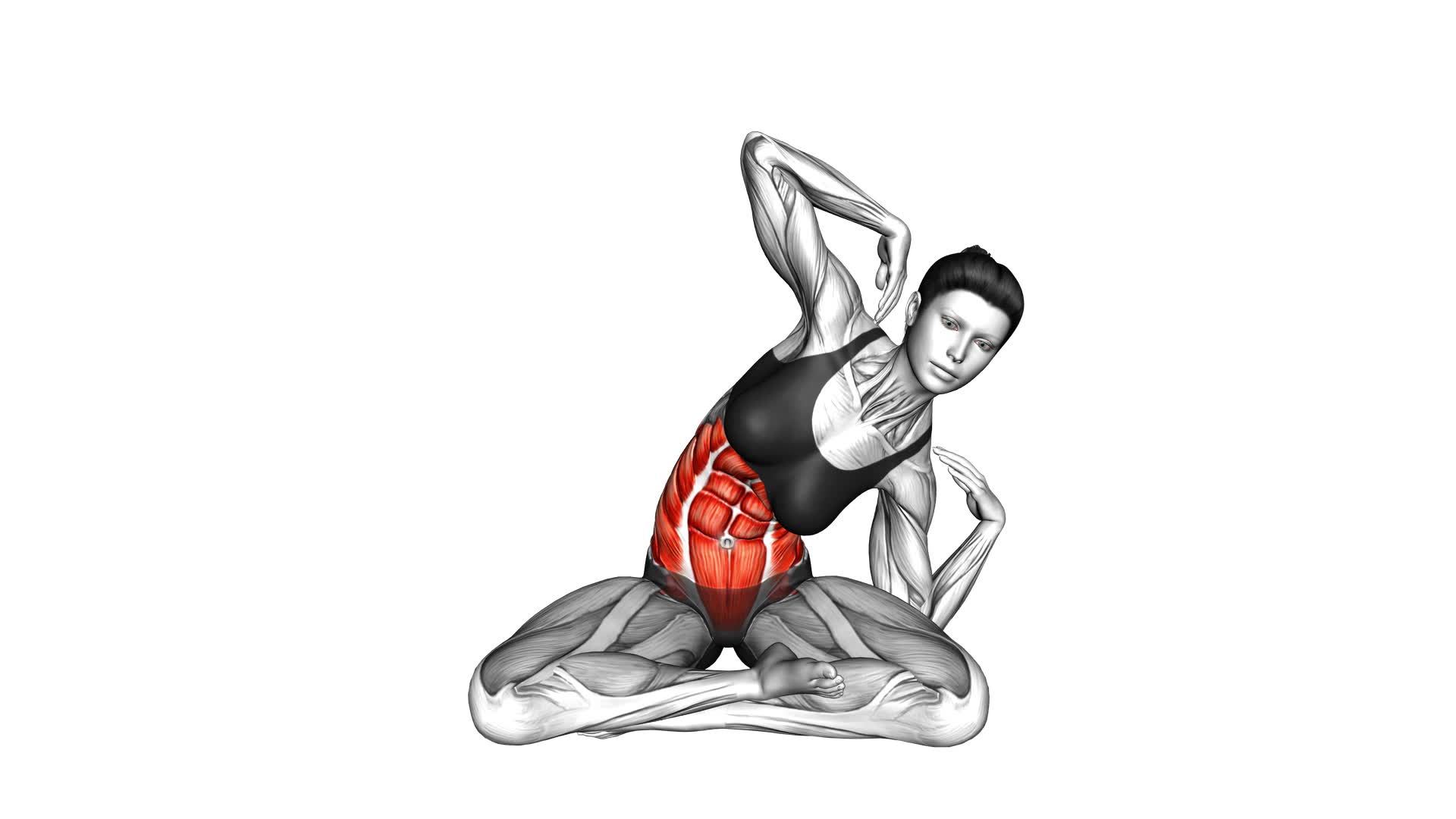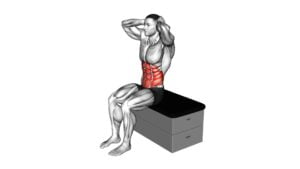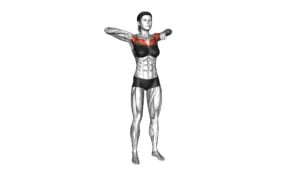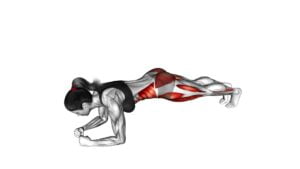Sitting Side Bend Elbow to Floor Tap (female) – Video Exercise Guide & Tips

Are you looking for an effective exercise to tone your core and improve your flexibility? Look no further than the Sitting Side Bend Elbow to Floor Tap!
Watch This Exercise Video
In this video exercise guide, we'll show you the proper form and setup, step-by-step instructions, common mistakes to avoid, modifications and progressions, as well as tips for maximizing the benefits.
Get ready to strengthen your abs and feel the burn with this dynamic workout. Let's dive in!
Key Takeaways
- Proper form and setup are important for the Sitting Side Bend Elbow to Floor Tap exercise, including sitting tall on a mat with legs crossed, straightening the spine, and relaxing the shoulders.
- The exercise involves slowly lowering the left elbow towards the floor on the left side while maintaining proper alignment and controlled movements.
- The step-by-step instructions for the exercise include starting in a seated position with legs extended and alternating between leaning to each side.
- Modification options are available for individuals with physical limitations, such as using a prop like a yoga block or pillow for support, reducing strain on the elbow, and adapting the exercise to individual needs.
Proper Form and Setup
To perform the Sitting Side Bend Elbow to Floor Tap exercise with proper form and setup, you'll need a mat and a comfortable seated position. Start by sitting tall on the mat with your legs crossed. Ensure that your spine is straight and your shoulders are relaxed. This proper alignment is crucial for the effectiveness of the exercise and to avoid any strain or injury.
As you prepare to begin the exercise, focus on your breathing techniques. Take a deep breath in through your nose, expanding your belly. As you exhale through your mouth, engage your core muscles and prepare to tilt your upper body to the side.
To execute the exercise, slowly lower your left elbow towards the floor on your left side, while keeping your right arm extended overhead. Tap the floor lightly with your elbow, feeling a stretch along the side of your body. Inhale as you return to the starting position, and then repeat the movement on the opposite side.
Remember to maintain proper alignment throughout the exercise, keeping your spine straight and your shoulders relaxed. Focus on controlled movements and breathe deeply to maximize the benefits of the Sitting Side Bend Elbow to Floor Tap exercise.
Step-By-Step Instructions
Now let's go over the key points for performing the Sitting Side Bend Elbow to Floor Tap exercise.
- First, you'll see a proper form demonstration to ensure you understand the correct technique.
- Second, there will be modification options available for those who need to adjust the intensity or difficulty level.
- Lastly, we'll cover common mistakes to avoid, so you can get the most out of this exercise and prevent any potential injuries.
Proper Form Demonstration
Start by positioning your body in a seated position with your legs extended in front of you.
To properly demonstrate the sitting side bend elbow to floor tap exercise, make sure to keep your back straight and engage your core muscles.
As you begin the movement, slowly lean your upper body to one side, reaching your elbow towards the floor while maintaining proper form.
Repeat on the other side, alternating between the left and right.
Remember, the key to a successful demonstration is to showcase the correct technique and variations of the exercise.
By doing so, you allow others to understand the benefits of maintaining proper form, such as improved flexibility and core strength.
Now, let's move on to the next section where we'll explore the modification options available for this exercise.
Modification Options Available
For modification options of the Sitting Side Bend Elbow to Floor Tap exercise, you can use a prop such as a yoga block or pillow to support your elbow as you reach towards the floor. This modification is beneficial for individuals who may have limited flexibility or strength in their upper body.
By using a prop, you can reduce the strain on your elbow and make the exercise more accessible. Place the prop on the floor next to you and rest your elbow on it while performing the side bend movement. This will help maintain stability and prevent discomfort.
Remember to engage your core and maintain proper alignment throughout the exercise. Modified exercises like this allow you to still engage in the workout while adapting it to your individual needs.
Common Mistakes to Avoid
To avoid common mistakes while performing the Sitting Side Bend Elbow to Floor Tap exercise, use proper form and maintain a strong core throughout the movement. Here are some technique tips to help you perform the exercise correctly:
- Avoid rounding your back: Keep your spine neutral and engage your core muscles to prevent any excessive rounding of the back.
- Don't collapse your shoulder: Keep your shoulder blades pulled back and down to maintain proper alignment and stability in the upper body.
- Control the movement: Slowly lower your elbow towards the floor while maintaining control throughout the motion. Avoid any sudden or jerky movements.
- Keep your hips stable: Avoid shifting or rotating your hips during the exercise. Maintain a stable base to ensure proper engagement of the core muscles.
By following these technique tips, you can perform the Sitting Side Bend Elbow to Floor Tap exercise effectively and reduce the risk of common mistakes.
Transitioning into the next section, let's now explore some of the common mistakes to avoid in more detail.
Common Mistakes to Avoid
To maximize the effectiveness of the Sitting Side Bend Elbow to Floor Tap exercise, it's crucial to be mindful of potential errors.
One common mistake to avoid is rounding your back during the side bend movement. It's important to maintain proper form by keeping your spine straight and tall throughout the exercise.
Another common mistake is using your arm to support your body weight instead of relying on your core muscles. Remember to engage your abs and obliques to perform the movement, rather than relying on your arm for support.
Additionally, be cautious of using excessive momentum or swinging movements to reach the floor with your elbow. This can compromise the integrity of the exercise and reduce its effectiveness. Aim for controlled and deliberate movements, focusing on the side bend and tap motion.
By avoiding these common mistakes and maintaining proper form, you can ensure that you're getting the most out of the Sitting Side Bend Elbow to Floor Tap exercise.
Now, let's move on to discuss modifications and progressions to challenge yourself further.
Modifications and Progressions
Now let's explore some advanced progressions for modifications of the Sitting Side Bend Elbow to Floor Tap exercise. These modifications can help you challenge yourself further and make the exercise more intense.
Additionally, we'll discuss the benefits of modified exercises and how they can help you achieve your fitness goals more efficiently.
Advanced Progressions for Modifications
You can take your modifications to the next level by incorporating advanced progressions. Here are four technique variations that will challenge your body even further:
- Increased Range of Motion: Extend your side bend further, reaching your elbow closer to the floor with each repetition. This will intensify the stretch and engage your oblique muscles more effectively.
- Weighted Side Bend: Hold a dumbbell or kettlebell in the hand opposite to the side you're bending towards. This added resistance will increase the difficulty and help build strength in your core.
- Dynamic Side Bend: Instead of holding the position, perform a controlled side-to-side movement, smoothly transitioning from one side to the other. This dynamic variation will enhance your stability and coordination.
- Side Plank Side Bend: Begin in a side plank position, then lower your hip towards the floor while maintaining a straight line from head to toe. Return to the starting position and repeat on the other side. This modification will challenge your core strength and stability even more.
Benefits of Modified Exercises
Incorporating advanced modifications and progressions into your exercise routine enhances the benefits of modified exercises. By making specific adjustments to exercises, you can tailor them to your individual needs and abilities, maximizing their effectiveness.
Modified exercises offer various advantages, such as allowing beginners or those with physical limitations to participate in workouts that may have otherwise been too challenging. These modifications can help prevent injuries and promote proper form and technique.
Additionally, modified exercises can target specific muscle groups, making them an excellent option for individuals who want to focus on strengthening certain areas of their body. They also provide a stepping stone for individuals looking to progress to more advanced exercises as they build strength and confidence.
Tips for Maximizing the Benefits
To maximize the benefits of the Sitting Side Bend Elbow to Floor Tap exercise, focus on maintaining proper form and engaging your core throughout the movement. Here are some tips to help you get the most out of this exercise:
- Keep your spine aligned: Maintain a tall posture throughout the exercise, avoiding any rounding or arching of the back. This will help target the side muscles effectively and prevent strain on the spine.
- Engage your core: As you bend sideways, imagine pulling your belly button towards your spine. This will activate your core muscles and provide stability and support to your spine.
- Control the movement: Slowly lower your elbow towards the floor, feeling the stretch on the side of your body. Avoid any jerky or sudden movements that can lead to injury. Focus on smooth and controlled motions.
- Breathe deeply: Inhale as you prepare for the movement and exhale as you tap your elbow to the floor. Deep breathing helps oxygenate your muscles, enhancing their performance and reducing the risk of injury.
By following these tips, you can maximize the results of the Sitting Side Bend Elbow to Floor Tap exercise while preventing any potential injuries.
Now, let's move on to the next section and discuss important safety precautions and considerations to keep in mind.
Safety Precautions and Considerations
Now let's explore what safety precautions and considerations should be taken into account while performing the Sitting Side Bend Elbow to Floor Tap exercise.
Injury prevention is key when engaging in any exercise routine. To prevent injury, it's important to warm up before starting the exercise. This can be done by performing some light cardiovascular activity to increase blood flow to the muscles.
Additionally, it's crucial to maintain proper form throughout the exercise. Keep your back straight and engage your core muscles to support your spine. Avoid any jerky or sudden movements, as this can strain your muscles.
Exercise modifications can be made to accommodate different fitness levels and abilities. If you're a beginner or have limited flexibility, you can start by performing the exercise without touching the floor with your elbow. Gradually work towards increasing the range of motion as you gain strength and flexibility.
If you experience any pain or discomfort while performing the exercise, it's important to stop immediately and consult with a healthcare professional. Listen to your body and only push yourself to a level that feels comfortable and safe.
Frequently Asked Questions
How Many Sets and Repetitions Should I Do for the Sitting Side Bend Elbow to Floor Tap Exercise?
For the sitting side bend elbow to floor tap exercise, it's important to focus on proper form and technique.
Start by sitting upright with your legs extended and your feet flexed.
Bend to one side, reaching your elbow towards the floor, then tap the floor with your fingertips.
Repeat on the other side.
Remember to engage your core and keep your back straight throughout the movement.
As for sets and repetitions, aim for 3 sets of 10-12 reps on each side.
Can I Perform This Exercise if I Have a Shoulder Injury?
If you have a shoulder injury, it's important to consult with a healthcare professional before attempting the Sitting Side Bend Elbow to Floor Tap exercise. They can provide modifications or alternatives that are safe for you.
This exercise primarily targets the oblique muscles and can help improve core strength and flexibility. However, if you have a shoulder injury, certain movements may aggravate the condition.
Always prioritize your safety and follow the advice of your healthcare provider.
Is It Necessary to Use a Mat or Any Other Equipment for This Exercise?
Using a mat or equipment for the sitting side bend elbow to floor tap exercise isn't necessary. This exercise can be done without any additional props.
To perform it, sit on the floor with your legs extended and bend to the side, reaching your elbow towards the floor.
However, it's important to maintain proper form and avoid straining your shoulder if you have an injury.
There are also variations of this exercise that can be done to modify the intensity.
Can I Do This Exercise if I Have Lower Back Pain?
If you have lower back pain, it's important to consult with a healthcare professional before attempting the Sitting Side Bend Elbow to Floor Tap exercise. This exercise involves bending to the side and tapping the elbow to the floor, which may put strain on the lower back.
Your healthcare professional can provide guidance on whether this exercise is safe for you and if modifications are necessary. Always prioritize your safety and listen to your body's signals.
How Long Should I Hold the Stretch in the Bottom Position of the Exercise?
To get the most out of the Sitting Side Bend Elbow to Floor Tap exercise, it's important to know how long to hold the stretch in the bottom position. The ideal time to hold the stretch is about 15-30 seconds. This allows your muscles to fully elongate and improve flexibility.
Beginners can modify this exercise by using a lighter weight or simply tapping the floor with their fingertips instead of their elbow.
Incorporating this exercise into your routine can help strengthen your core and improve overall posture.
Conclusion
To maximize the benefits of the sitting side bend elbow to floor tap exercise, it's crucial to maintain proper form and follow the step-by-step instructions.
Avoid common mistakes and consider modifications or progressions based on your fitness level.
Remember to prioritize safety by listening to your body and not pushing yourself too hard.
By incorporating this exercise into your routine, you can strengthen your core and improve flexibility.

Author
Years ago, the spark of my life’s passion ignited in my mind the moment I stepped into the local gym for the first time. The inaugural bead of perspiration, the initial endeavor, the very first surge of endorphins, and a sense of pride that washed over me post-workout marked the beginning of my deep-seated interest in strength sports, fitness, and sports nutrition. This very curiosity blossomed rapidly into a profound fascination, propelling me to earn a Master’s degree in Physical Education from the Academy of Physical Education in Krakow, followed by a Sports Manager diploma from the Jagiellonian University. My journey of growth led me to gain more specialized qualifications, such as being a certified personal trainer with a focus on sports dietetics, a lifeguard, and an instructor for wellness and corrective gymnastics. Theoretical knowledge paired seamlessly with practical experience, reinforcing my belief that the transformation of individuals under my guidance was also a reflection of my personal growth. This belief holds true even today. Each day, I strive to push the boundaries and explore new realms. These realms gently elevate me to greater heights. The unique combination of passion for my field and the continuous quest for growth fuels my drive to break new ground.







